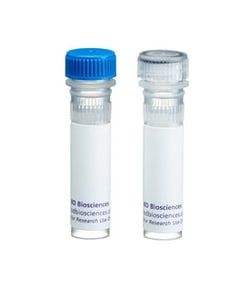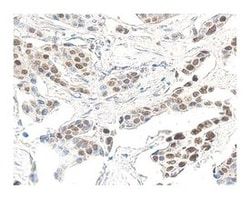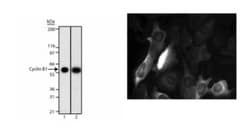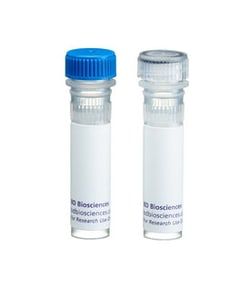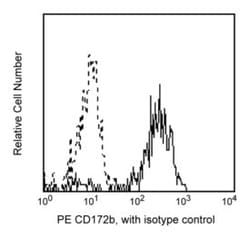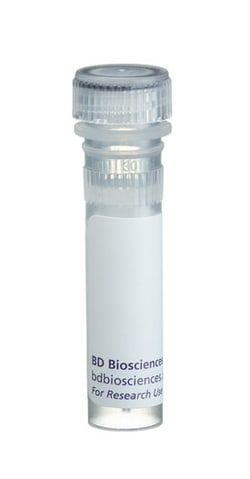BDB552597
Cleaved PARP (Asp214) w/control Mouse anti-Human, Unlabeled, Clone: F21-852, BD
Manufacturer: Fischer Scientific
Select a Size
| Pack Size | SKU | Availability | Price |
|---|---|---|---|
| Each of 1 | BDB552597-Each-of-1 | In Stock | ₹ 50,374.00 |
BDB552597 - Each of 1
In Stock
Quantity
1
Base Price: ₹ 50,374.00
GST (18%): ₹ 9,067.32
Total Price: ₹ 59,441.32
Antigen
Cleaved PARP (Asp214) w/control
Classification
Monoclonal
Concentration
0.5mg/mL
Formulation
Aqueous buffered solution containing ≤0.09% sodium azide.
Immunogen
Human cleaved PARP
Quantity
150 μg
Research Discipline
Cell Biology
Target Species
Human
Isotype
IgG1
Applications
Western Blot
Clone
F21-852
Conjugate
Unconjugated
Host Species
Mouse
Purification Method
Affinity Purified
Regulatory Status
RUO
Primary or Secondary
Primary
Content And Storage
Store undiluted at -20°C.
Related Products
Description
- PARP (Poly [ADP-Ribose] Polymerase) is a 113-kDa nuclear chromatin-associated enzyme that catalyzes the transfer of ADP-ribose units from NAD+ to a variety of nuclear proteins including topoisomerases, histones, and PARP itself
- The catalytic activity of PARP is increased in cells following DNA damage, and PARP is thought to play an important role in mediating the normal cellular response to DNA damage
- Additionally, PARP is a target of the caspase protease activity associated with apoptosis
- The PARP protein consists of an N-terminal DNA-binding domain (DBD) and a C-terminal catalytic domain separated by a central automodification domain
- During apoptosis, Caspase-3 cleaves PARP at a recognition site (Asp Glu Val Asp Gly) in the DBD to form 24- and 89-kDa fragments
- This process separates the DBD (which is mostly in the 24-kDa fragment) from the catalytic domain (in the 89-kDa fragment) of the enzyme, resulting in the loss of normal PARP function
- It has been proposed that inactivation of PARP directs DNA-damaged cells to undergo apoptosis rather than necrotic degradation, and the presence of the 89-kDa PARP cleavage fraction is considered to be a marker of apoptosis
- A peptide corresponding to the N-terminus of the cleavage site (Asp 214) of human PARP was used as the immunogen
- The F21-852 monoclonal antibody reacts only with the 89-kDa fragment of human PARP-1 that is downstream of the Caspase-3 cleavage site (Asp214) and contains the automodification and catalytic domains
- It does not react with intact human PARP-1
- Cross-reactivity with other members of the PARP superfamily is unknown
- Recognition of cleaved PARP in mouse cells has been demonstrated, and it may also cross-react with a number of other species due to the conserved nature of the molecule.
Compare Similar Items
Show Difference
Antigen: Cleaved PARP (Asp214) w/control
Classification: Monoclonal
Concentration: 0.5mg/mL
Formulation: Aqueous buffered solution containing ≤0.09% sodium azide.
Immunogen: Human cleaved PARP
Quantity: 150 μg
Research Discipline: Cell Biology
Target Species: Human
Isotype: IgG1
Applications: Western Blot
Clone: F21-852
Conjugate: Unconjugated
Host Species: Mouse
Purification Method: Affinity Purified
Regulatory Status: RUO
Primary or Secondary: Primary
Content And Storage: Store undiluted at -20°C.
Antigen:
Cleaved PARP (Asp214) w/control
Classification:
Monoclonal
Concentration:
0.5mg/mL
Formulation:
Aqueous buffered solution containing ≤0.09% sodium azide.
Immunogen:
Human cleaved PARP
Quantity:
150 μg
Research Discipline:
Cell Biology
Target Species:
Human
Isotype:
IgG1
Applications:
Western Blot
Clone:
F21-852
Conjugate:
Unconjugated
Host Species:
Mouse
Purification Method:
Affinity Purified
Regulatory Status:
RUO
Primary or Secondary:
Primary
Content And Storage:
Store undiluted at -20°C.
Antigen: __
Classification: __
Concentration: __
Formulation: __
Immunogen: __
Quantity: __
Research Discipline: __
Target Species: __
Isotype: __
Applications: __
Clone: __
Conjugate: __
Host Species: __
Purification Method: __
Regulatory Status: __
Primary or Secondary: __
Content And Storage: 4°C
Antigen:
__
Classification:
__
Concentration:
__
Formulation:
__
Immunogen:
__
Quantity:
__
Research Discipline:
__
Target Species:
__
Isotype:
__
Applications:
__
Clone:
__
Conjugate:
__
Host Species:
__
Purification Method:
__
Regulatory Status:
__
Primary or Secondary:
__
Content And Storage:
4°C
Antigen: CD172b
Classification: Monoclonal
Concentration: __
Formulation: Aqueous buffered solution containing BSA and ≤0.09% sodium azide.
Immunogen: Human SIRPβ1 extracellular domain Recombinant Protein
Quantity: 100 Tests
Research Discipline: Immunology
Target Species: Human
Isotype: IgG1 κ
Applications: Flow Cytometry
Clone: B4B6
Conjugate: PE
Host Species: Mouse
Purification Method: Affinity Purified
Regulatory Status: RUO
Primary or Secondary: Primary
Content And Storage: Store undiluted at 4°C and protected from prolonged exposure to light. Do not freeze.
Antigen:
CD172b
Classification:
Monoclonal
Concentration:
__
Formulation:
Aqueous buffered solution containing BSA and ≤0.09% sodium azide.
Immunogen:
Human SIRPβ1 extracellular domain Recombinant Protein
Quantity:
100 Tests
Research Discipline:
Immunology
Target Species:
Human
Isotype:
IgG1 κ
Applications:
Flow Cytometry
Clone:
B4B6
Conjugate:
PE
Host Species:
Mouse
Purification Method:
Affinity Purified
Regulatory Status:
RUO
Primary or Secondary:
Primary
Content And Storage:
Store undiluted at 4°C and protected from prolonged exposure to light. Do not freeze.
Antigen: R-Phycoerythrin
Classification: Monoclonal
Concentration: 0.5mg/mL
Formulation: Aqueous buffered solution containing ≤0.09% sodium azide.
Immunogen: R-phycoerythrin
Quantity: 0.1 mg
Research Discipline: Immunology
Target Species: __
Isotype: IgG1 κ
Applications: Flow Cytometry
Clone: E31-1459
Conjugate: Biotin
Host Species: Mouse
Purification Method: Affinity Purified
Regulatory Status: RUO
Primary or Secondary: Primary
Content And Storage: Store undiluted at 4°C and protected from prolonged exposure to light. Do not freeze.
Antigen:
R-Phycoerythrin
Classification:
Monoclonal
Concentration:
0.5mg/mL
Formulation:
Aqueous buffered solution containing ≤0.09% sodium azide.
Immunogen:
R-phycoerythrin
Quantity:
0.1 mg
Research Discipline:
Immunology
Target Species:
__
Isotype:
IgG1 κ
Applications:
Flow Cytometry
Clone:
E31-1459
Conjugate:
Biotin
Host Species:
Mouse
Purification Method:
Affinity Purified
Regulatory Status:
RUO
Primary or Secondary:
Primary
Content And Storage:
Store undiluted at 4°C and protected from prolonged exposure to light. Do not freeze.
